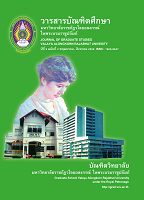รูปแบบการบริหารจัดการกองทุนหลักประกันสุขภาพระดับท้องถิ่น ในเครือข่ายเขตบริการสุขภาพที่ 7 กลุ่มจังหวัดร้อยแก่นสารสินธุ์ (ร้อยเอ็ด ขอนแก่น มหาสารคาม และกาฬสินธุ์)
Main Article Content
Abstract
การศึกษาวิจัยนี้มีวัตถุประสงค์เพื่อ 1) ศึกษาปัจจัยที่เกี่ยวข้องในการบริหารจัดการกองทุนหลักประกันสุขภาพระดับท้องถิ่น 2) ศึกษาระดับความสำเร็จในการบริหารจัดการกองทุนหลักประกันสุขภาพระดับท้องถิ่น 3) ศึกษาปัจจัยที่มีอิทธิพลต่อความสำเร็จในการบริหารจัดการกองทุนหลักประกันสุขภาพระดับท้องถิ่น และ 4) เพื่อสร้างรูปแบบการบริหารจัดการกองทุนหลักประกันสุขภาพระดับท้องถิ่น ในเครือข่ายเขตบริการสุขภาพที่ 7 กลุ่มจังหวัดร้อยแก่นสารสินธุ์ (ร้อยเอ็ด ขอนแก่น มหาสารคาม และกาฬสินธุ์) ผู้วิจัยใช้วิธีวิจัยแบบผสานวิธี คือ วิธีวิจัยเชิงคุณภาพและวิธีวิจัยเชิงปริมาณ วิธีวิจัยเชิงคุณภาพ ศึกษากลุ่มตัวอย่างเป้าหมาย ได้แก่ ผู้ทรงคุณวุฒิที่เกี่ยวข้องกับการบริหารจัดการกองทุนหลักประกันสุขภาพระดับท้องถิ่น ในเครือข่ายเขตบริการสุขภาพที่ 7 กลุ่มจังหวัดร้อยแก่นสารสินธุ์ จำนวน 20 คน ใช้วิธีการสุ่มแบบเฉพาะเจาะจง โดยการสัมภาษณ์เชิงลึก วิเคราะห์ข้อมูลโดยการวิเคราะห์เนื้อหา และวิธีวิจัยเชิงปริมาณ ศึกษาจากประชากร กองทุนหลักประกันสุขภาพระดับท้องถิ่นในเขตพื้นที่เครือข่ายบริการสุขภาพที่ 7 กลุ่มจังหวัดร้อยแก่นสารสินธุ์ จำนวน 722 กองทุน ขนาดกลุ่มตัวอย่างใช้เกณฑ์การวิเคราะห์สมการโครงสร้างความสัมพันธ์เชิงเส้นตรงไม่ควรน้อยกว่า 20 เท่าต่อ 1 ตัวแปร ในการวิจัยครั้งนี้มีตัวแปรทั้งหมด 12 ตัวแปร กำหนดขนาดกลุ่มตัวอย่าง จำนวน 280 กองทุน สุ่มตัวอย่างแบบหลายขั้นตอน เครื่องมือที่ใช้เป็นแบบสอบถาม วิเคราะห์ข้อมูลด้วยสถิติเชิงพรรณนา ได้แก่ การแจกแจงความถี่ ค่าร้อยละ ค่าเฉลี่ย และค่าส่วนเบี่ยงเบนมาตรฐาน สถิติวิเคราะห์ ใช้ การวิเคราะห์ค่าสัมประสิทธิ์สหสัมพันธ์เพียร์สัน (Pearson Correlation) ที่ระดับนัยสำคัญทางสถิติ p-value ≤ 0.05 การวิเคราะห์อิทธิพลเส้นทาง (Path Analysis) และการวิเคราะห์ตัวแบบสมการโครงสร้างเชิงเส้น
ผลการวิจัยพบว่า
1. การบริหารจัดการกองทุนหลักประกันสุขภาพระดับท้องถิ่นฯ พบว่ามีปัจจัยที่เกี่ยวข้องได้แก่ ความรู้ ความเข้าใจเกี่ยวกับการดำเนินงานกองทุน การบริหารจัดการ ผู้นำ การรับรู้บทบาทหน้าที่ของ คณะกรรมการบริหารกองทุน การวางแผนสุขภาพชุมชน ความคาดหวังในประโยชน์ที่ได้รับเกี่ยวกับกองทุน การจัดทำกิจกรรมบริการสุขภาพตามชุดสิทธิประโยชน์ การสนับสนุนงบประมาณแก่หน่วยบริการสุขภาพในพื้นที่ การมีส่วนร่วมของคณะกรรมการบริหารกองทุน การมีส่วนร่วมของประชาชนและชุมชน และการประชาสัมพันธ์กองทุน
2. ระดับความสำเร็จในการบริหารจัดการกองทุนหลักประกันสุขภาพระดับท้องถิ่นฯ โดยภาพรวมอยู่ในระดับสูงค่าเฉลี่ย เท่ากับ 3.44 ส่วนเบี่ยงเบนมาตรฐาน เท่ากับ 0.76 เรียงลำดับค่าเฉลี่ยจากมากไปน้อย ได้แก่ ความสำเร็จด้านการร่วมรับประโยชน์จากกองทุนค่าเฉลี่ย เท่ากับ 4.52 ส่วนเบี่ยงเบนมาตรฐานเท่ากับ 0.73 ด้านการบริหารจัดการแบบมีส่วนร่วมค่าเฉลี่ย เท่ากับ 3.31 ส่วนเบี่ยงเบนมาตรฐาน เท่ากับ 0.76 และ ด้านการสร้างนวัตกรรมแบบมีส่วนร่วม ค่าเฉลี่ย เท่ากับ 2.48 ส่วนเบี่ยงเบนมาตรฐาน เท่ากับ 0.81ตามลำดับ
3. ปัจจัยที่มีอิทธิพลต่อความสำเร็จในการบริหารจัดการกองทุนหลักประกันสุขภาพระดับท้องถิ่นฯ จากการวิเคราะห์อิทธิพลเส้นทาง สามารถพยากรณ์ได้ร้อยละ 76.50 อย่างมีนัยสำคัญทางสถิติ ( R2=0.765, p-value ≤ 0.05) เรียงลำดับค่าสัมประสิทธิ์อิทธิพลโดยรวมจากมากไปน้อย คือ ปัจจัยด้านการบริหารจัดการ(0.38) ปัจจัยด้านการประชาสัมพันธ์กองทุน (0.26) ปัจจัยด้านความรู้ ความเข้าใจเกี่ยวกับการดำเนินงานกองทุน (0.23) ปัจจัยด้านการรับรู้บทบาทหน้าที่ของคณะกรรมการบริหารกองทุน (0.19) ปัจจัยด้านผู้นำ (0.18) ปัจจัยด้านการจัดทำกิจกรรมบริการสุขภาพตามชุดสิทธิประโยชน์ และปัจจัยด้านการมีส่วนร่วมของคณะกรรมการบริหารกองทุน เท่ากัน (0.10) และปัจจัยด้านการมีส่วนร่วมของประชาชนและชุมชน (-0.18) ตามลำดับ
4. รูปแบบการบริหารจัดการกองทุนหลักประกันสุขภาพระดับท้องถิ่น ในเครือข่ายเขตบริการสุขภาพที่ 7 กลุ่มจังหวัดร้อยแก่นสารสินธุ์ จากการทดสอบตัวแบบสมการโครงสร้างเชิงเส้นจากปัจจัยที่มีอิทธิพลต่อการบริหารจัดการกองทุนหลักประกันสุขภาพระดับท้องถิ่นฯ พบว่ารูปแบบ มีความสอดคล้องกลมกลืนกับข้อมูลเชิงประจักษ์ ค่า = 1.44, df = 2, p-value = 0.485, GFI = 1.00, AGFI = 0.97, RMSEA = 0.00, RMR = 0.0025, CN = 1775.04
ABSTRACT
The objectives of this research are to 1) study factors related to the level of local health assurance fund management, 2) study success level in local health assurance fund management. 3) Study factors influencing on the success in local health assurance fund management, and 4) build a management model of local health assurance fund within 7th health servicing network of Roi-Kaen Sarasin Provincial Group. This research is mixed methods research combining both qualitative and quantitative research methodology. For qualitative research method, the target group were 20 scholars selected by specific random technique and related in the local health assurance fund management in 7th health service network of Roi-Kaen Sarasin Provincial Group through the methods of in-depth interview, data analysis was made by content analysis. For quantitative research method, the samplings of 722 people from Funds within local health assurance in 7th health service network of Roi-Kaen Sarasin Provincial Group. Research sampling size selection was based on linier structural relationship assumption that should not be less than 20 times per one factor. This research consisted of 12 factors, proportionally selected out of setting of 280 Funds which was done by many steps of sampling. Research tools were questionnaires, descriptive statistical methods analysis such as Frequency, Distribution, Percentile, Average, and Standard Deviation were used for data analysis inciuding Pearson Correlation set of Significent p-value ≤ 0.05, Path Anaysis and linear structural relationship.
The research results were found as follows;
1. The level of local health assurance fund management factors related were found knowledge and understanding of fund operations, management, leader, roles and responsibility awareness of fund management committee, community health planning, benefit expectorations to receive related to the fund, health service activity organization based on privilege package, budgeting support for health servicing units in the area, participation of fund management committee, participation of the people and community, and fund public relations.
2. The overall success in local health assurance fund management was at high-level ( ) = 3.44, S.D=0.76, with average ranking from highest to lowest level of the success in receiving benefits from the fund (
) = 4.52, S.D = 0.73, in participative management (
) = 3.31, S.D=0.76 and in building participative innovation (
) = 2.48, S.D=0.81. Respectively.
3. Factors influencing on the success in local level health assurance fund management within 7th health service network of Roi-Kean Sarasin Provincial Group by Path Analysis were able to predict at 76.50% with the statistical significance at (R2 = 0.765, p-value ≤ 0.05) by ranking co efficiency values of overall influence from highest to lowest level as seen in the management factor (0.38), fund public relation actor (0.26), factor of knowledge and understanding in fund operations (0.23), factor of roles and responsibility awareness of fund management committee (0.19), leadership factor (0.18), factors related to health servicing activity organization based on privileges package, and factor on participation of fund management committee (0.10) and factor on the participation of the people and community (-0.18), respectively.
4. The model of a management for local health assurance management fund within 7th health servicing network of Roi-Kaen Sarasin Provincial Group from factors influencing the success in local health assurance management fund was the linear structural model which was in harmony with the empirical data ( = 1.44, df = 2, p-value = 0.485, GFI = 1.00, AGFI = 0.97, RMSEA = 0.00, RMR = 0.0025, CN = 1775.04).
Article Details
บทความทุกเรื่องได้รับการตรวจความถูกต้องทางวิชาการโดยผู้ทรงคุณวุฒิ ทรรศนะและข้อคิดเห็นในบทความวารสารบัณฑิตศึกษา มหาวิทยาลัยราชภัฏวไลยอลงกรณ์ ในพระบรมราชูปถัมภ์ มิใช่เป็นทรรศนะและความคิดของผู้จัดทำจึงมิใช่ความรับผิดชอบของบัณฑิตวิทยาลัย มหาวิทยาลัยราชภัฏวไลยอลงกรณ์ ในพระบรมราชูปถัมภ์ กองบรรณาธิการไม่สงวนสิทธิ์การคัดลอก แต่ให้อ้างอิงแหล่งที่มา


